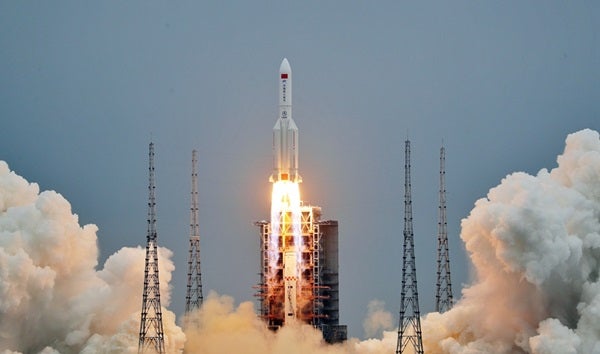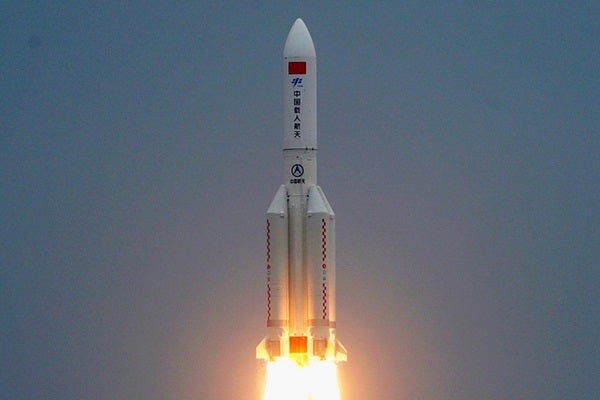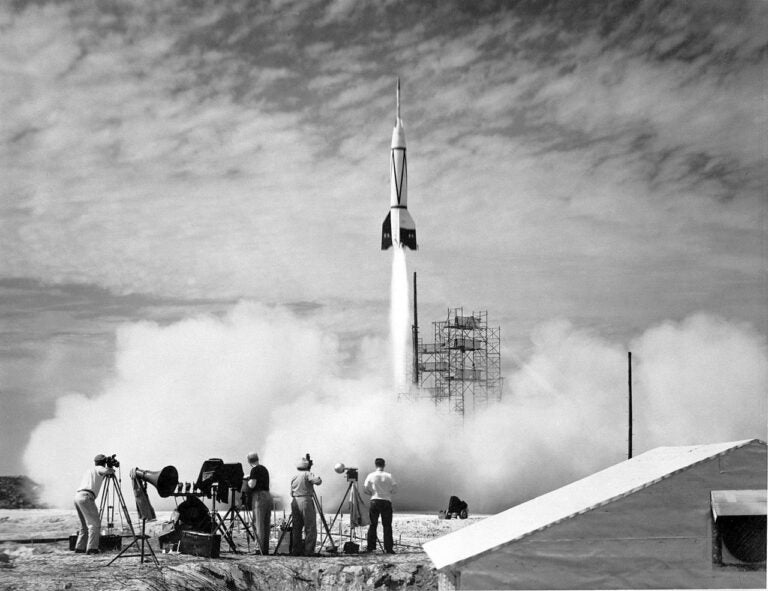A Chinese rocket that launched to orbit around Earth last week is now out of control and expected to reenter the atmosphere around May 8 or 9.
The 20-ton Long March 5B booster launched on April 28 from the Wenchang Spacecraft Launch Site on Hainan Island, off the southern coast of the Chinese mainland. It was carrying part of what will be the China National Space Administration’s (CNSA) next space station, Tiangong, which means “heavenly palace.”
But after the rocket lofted a station module, dubbed Tianhe, to orbit, observers around the world noticed that the booster itself didn’t fall back down. The rocket achieved orbit, along with its payload, but it apparently has no way to deorbit itself in a controlled fashion.
According to tracking data from the U.S. Space Force available at Space-Track.org, the launcher is now orbiting with a maximum altitude, or apogee, of 178 miles (286 kilometers). That means it is experiencing drag from air molecules at the fringes of Earth’s upper atmosphere, so the booster’s destiny is to reenter the atmosphere within days.
A matter of time
Predicting exactly when and where the rocket will reenter is tricky. To lift a phrase from Hemingway, uncontrolled reentries happen in two phases: gradually, then suddenly. That’s because as spacecraft descend into thicker air, the drag they experience increases, too. And it does so in an unpredictable fashion that depends on atmospheric conditions.
A model from The Aerospace Corporation estimates that the booster will reenter Earth’s atmosphere around 2:30 a.m. UT on May 9, but the uncertainty of the prediction is plus or minus 21 hours. Given that the rocket completes an orbit roughly every 90 minutes, it could land virtually anywhere between the latitudes of 41.5 degrees north and south, which spans locations from New York City to Wellington, New Zealand.
Though most of the rocket will burn up in the atmosphere, some parts are expected to survive. And while the odds of them causing damage on the ground are low — the ocean remains the most likely landing spot — they are not negligible.
“The risk of a particular person getting hit is incredibly tiny,” says Harvard–Smithsonian astrophysicist Jonathan McDowell. “The risk of someone being hit is rather too large.”
Adding to the concern is the fact that this will not be the first time a Long March 5B has made an uncontrolled reentry: After the rocket’s inaugural launch in May 2020, it became clear that it failed to — or was never intended to — deorbit in a controllable fashion. It reentered the atmosphere off of western Africa on May 11 and showered debris across the nation of Côte d’Ivoire. One pipe thought to be part of the craft was 39 feet (12 meters) long.
Then-NASA administrator Jim Bridenstine labelled the incident “really dangerous,” Space News reported. “It flew over population centers and it reentered Earth’s atmosphere. It could have been extremely dangerous. We’re really fortunate in the sense that it doesn’t appear to have hurt anybody.”
Design decision
The impending reentry has renewed criticism of China’s space agency for flying a rocket that apparently has no deorbit capability.
Most modern rockets launch in stages: Initial stages and booster rockets fall back to Earth, while final stages that carry payloads to orbit are designed to restart their engine and perform a deorbit burn. But the Long March 5B has a single core stage, augmented by boosters, that travels all the way to orbit with its payload.
After the latest Long March 5B launch, McDowell criticized the design on Twitter. “This was not an accident, it was poor design of the rocket,” he said on Twitter. “The fact that the massive core stage stays in orbit is how this rocket is designed, and that’s the easy (but negligent) way to do it.”
Chinese state media has downplayed concerns about potential damage from falling debris as “Western hype.” The Global Times, a hawkish tabloid published by the Chinese Communist Party outlet People’s Daily, quoted Song Zhongping, a Chinese military expert, as saying, “It’s an old trick used by hostile powers every time they see technological breakthroughs in China, as they are nervous.”
The Global Times also said the debris was likely to fall in international waters.
“[C]orrect, but you don’t know that for sure,” McDowell responded on Twitter. He added that he disagreed that concerns about damage were “Western hype,” pointing out, “The last one caused damage!”
Out of control
The two Long March 5B reentries rank as some of the largest objects in the history of spaceflight to make a less-than-controlled reentry. The record is held by Skylab, the first U.S. space station, which reentered over the Indian Ocean in 1979. NASA’s attempts to alter its descent to avoid inhabited areas were only partially successful, and some pieces reached the ground in western Australia.
This is also unlikely to be the last uncontrolled reentry by a Long March 5B: Ten more launches are required to lift the rest of the Tiangong space station’s components to orbit, with completion scheduled by the end of 2022.
The specter of repeated uncontrolled reentries threatens to overshadow China’s plans for Tiangong. Featuring two laboratory modules, Tiangong will be the nation’s first multi-module space station, weighing in at a total of nearly 70 tons. CNSA has already signed an agreement with the United Nations Office for Outer Space Affairs and says that 17 nations have confirmed they will participate in scientific research aboard the station.











